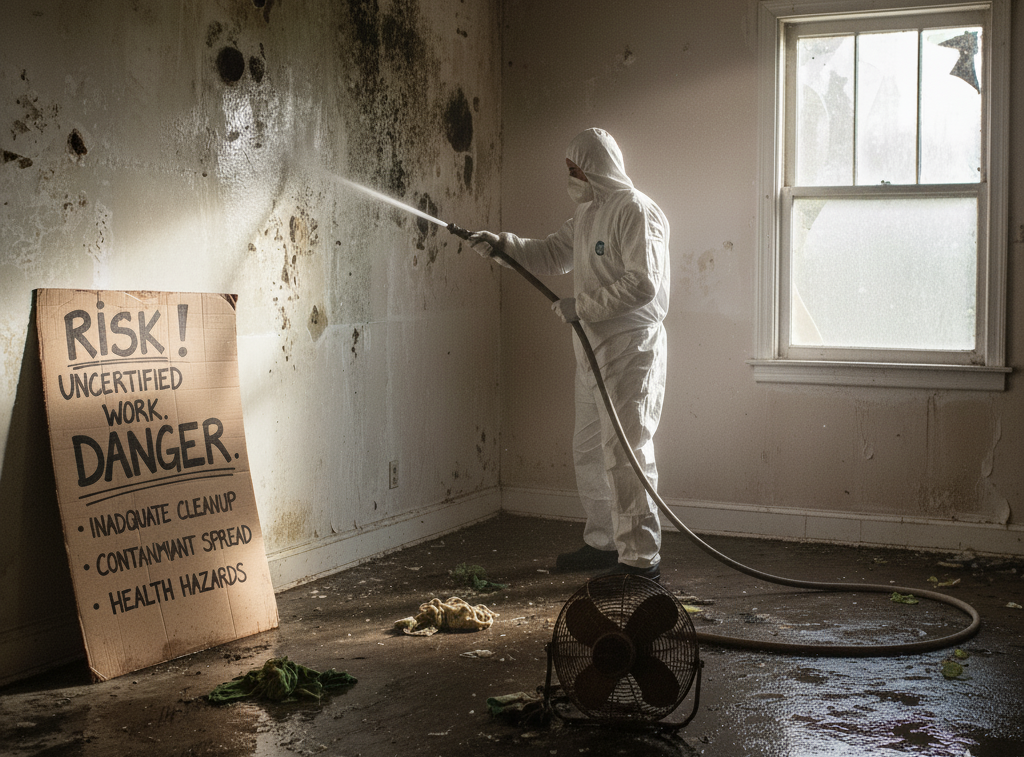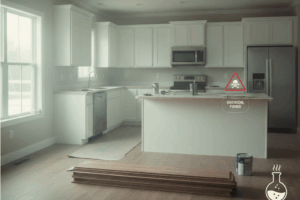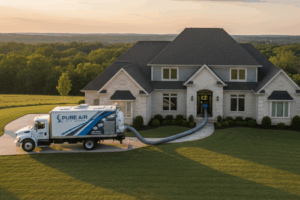
The Risks of Uncertified Mold Remediation: What Homeowners Need to Know
⚠️ The Real Risks of Uncertified Mold Remediation & Water Damage Work
Mold remediation and water damage restoration are not jobs for amateurs. Unfortunately, too many property owners take shortcuts by hiring unlicensed or uncertified workers—and pay the price in health, safety, and long-term repair costs.
Let’s explore the real dangers of uncertified work in this field and how IAQCert-trained professionals ensure these hazards are avoided.
🛑 What Can Go Wrong with Uncertified Mold Remediation?
Hiring uncertified workers for mold-related tasks can result in:
1. Inadequate Containment and Cleanup
Untrained individuals often lack proper containment procedures, allowing spores to spread during cleanup. This leads to:
- Mold regrowth in new areas
- Contamination of HVAC systems
- Higher long-term remediation costs
2. Incorrect Identification of Mold Species
Not all mold is created equal. Without certification, workers may:
- Miss toxic varieties like Stachybotrys chartarum (black mold)
- Misidentify harmless discoloration as dangerous mold
- Fail to determine moisture sources behind growth
Learn how trained professionals perform proper assessments through our Certified Mold Inspection Technician (CMIT) course.
3. Improper Use of Chemicals and PPE
Uncertified workers may use:
- Unsafe or ineffective biocides
- Inappropriate cleaning agents for surfaces
- Insufficient personal protective equipment (PPE), risking their own health and cross-contamination
🧠 Why Certification Matters: What Professionals Learn
At IAQCert, our Certified Mold Remediation Technician (CMRT) program trains professionals in:
✅ Mold types and health risks
✅ Safe containment and removal practices
✅ Use of HEPA vacuums and air scrubbers
✅ Proper PPE protocols and OSHA guidelines
✅ Final clearance testing for post-remediation validation
Certified technicians are trained to protect both the occupants and the structure, ensuring remediation is done right the first time.
🌊 The Overlooked Danger: Water Damage Left Untreated
Water damage often leads to mold—but the initial mistake often starts earlier, with uncertified water damage restoration.
When handled poorly, water damage cleanup can result in:
- Long-term moisture retention inside walls and floors
- Undetected microbial growth
- Structural deterioration (warped floors, rotting wood)
- Electrical and fire hazards from wet systems
Professionals trained through our Certified Water Damage Restoration Technician (CWDRT) course know how to:
✅ Locate hidden moisture using thermal and moisture detection tools
✅ Set up appropriate drying systems and dehumidification
✅ Prevent microbial amplification
✅ Document and report damages for insurance or legal use
🧬 The Health Risks of Uncertified Work
Mold exposure has been linked to:
- Asthma and respiratory irritation
- Allergic reactions and rashes
- Headaches, fatigue, and brain fog
- Increased vulnerability in children, the elderly, and immunocompromised individuals
If mold isn’t completely removed, or if it spreads further due to poor remediation, everyone in the space is at risk—including pets.
🔒 Peace of Mind: Why You Should Demand IAQCert Certification
Choosing IAQCert-certified professionals ensures that your property is in the hands of someone who:
✅ Has passed a competency-based assessment
✅ Understands how to comply with industry safety standards
✅ Has real-world training with proper tools and procedures
✅ Can provide proof of certification via a scannable digital ID card (compatible with Apple & Google Wallet)
✅ Is part of a community committed to continuing education and ethical service
You can verify their status instantly using our Certification Lookup Tool.
🛠️ Don’t Cut Corners When It Comes to Mold & Moisture
Uncertified remediation and water damage restoration is a gamble with your health, your property, and your wallet. Whether you’re a homeowner, landlord, property manager, or real estate professional, insisting on certification is the safest and smartest move.
🔗 Explore our courses:
- Certified Mold Inspection Technician (CMIT)
- Certified Water Damage Restoration Technician (CWDRT)
- Certified Mold Remediation Technician (CMRT)
🔗 External Resources
✅ Final Word
When it comes to mold and water damage, certification isn’t optional—it’s essential. By choosing IAQCert-trained professionals, you’re investing in safety, quality, and long-term protection.



